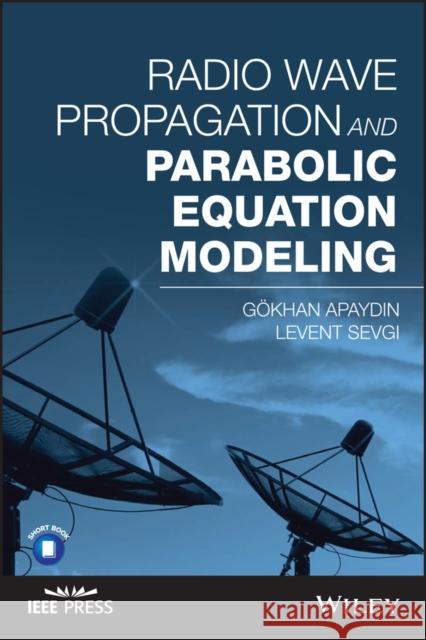Radio Wave Propagation and Parabolic Equation Modeling » książka



Radio Wave Propagation and Parabolic Equation Modeling
ISBN-13: 9781119432111 / Angielski / Miękka / 2017 / 152 str.
Radio Wave Propagation and Parabolic Equation Modeling
ISBN-13: 9781119432111 / Angielski / Miękka / 2017 / 152 str.
(netto: 254,56 VAT: 5%)
Najniższa cena z 30 dni: 264,01
ok. 30 dni roboczych.
Darmowa dostawa!
An important contribution to the literature that introduces powerful new methods for modeling and simulating radio wave propagation A thorough understanding of electromagnetic wave propagation is fundamental to the development of sophisticated communication and detection technologies.
Preface ix
Acronyms xi
Matlab Codes xiii
Chapter 1: INTRODUCTION 1
1.1 Electromagnetic Problems and Classification 1
1.2 Maxwell Equations 3
1.3 Guided Waves and Transverse/Longitudinal Decomposition 4
1.4 Two Dimensional Helmholtz′s Equation 5
1.5 Validation, Verification, and Calibration Procedure 6
1.6 Fourier Transform, DFT and FFT 7
Chapter 2: WAVE PROPAGATION OVER FLAT EARTH 15
2.1 Flat Earth and GO Two–Ray Model 15
2.2 Single Knife Edge Problem and Four–Ray Model 16
2.3 Vertical Linear Refractivity Profile and Mode Summation 19
Chapter 3: PARABOLIC EQUATION MODELING 23
3.1 Introduction 23
3.2 Parabolic Wave Equation Form 24
3.3 Dirichlet, Neumann, and Cauchy Boundary Conditions 27
3.4 Antenna/Source Injection 28
3.5 Split–Step Parabolic Equation (SSPE) Model 29
3.5.1 Narrow–Angle and Wide–Angle SSPE 30
3.5.2 A MATLAB–Based Simple SSPE Code 30
3.6 FEM–Based Parabolic Equation Model 32
3.7 Atmospheric Refractivity Effects 40
Chapter 4: WAVE PROPAGATION AT SHORT RANGES 43
4.1 Introduction 43
4.2 Accurate Source Modeling 44
4.3 Wave Propagators in Two Dimensions 47
4.3.1 Flat Earth and Two–Ray Model 47
4.3.2 FEM–Based PE Wave Propagator 49
4.3.3 SSPE–Based PE Wave Propagator 49
4.3.4 Method of Moments Modeling 49
4.4 Knife Edge and Four Ray Model 49
4.5 Canonical Tests and Calibration 50
Chapter 5: PE AND TERRAIN MODELING 53
5.1 Irregular PEC Terrain 53
5.2 PE and Impedance Boundary Modeling 54
5.2.1 Discrete Mixed Fourier Transform (DMFT) 56
5.3 Numerical Results and Comparison 57
Chapter 6: ANALYTICAL EXACT AND APPROXIMATE MODELS 65
6.1 Wave Propagation in a Parallel Plate Waveguide 65
6.2 Green′s Function in Terms of Mode Summation 68
6.3 Mode Summation for a Tilted Gaussian Source 70
6.4 A Hybrid Ray + Image Method 71
6.5 Numerical Models 73
6.5.1 Parabolic Equation Models: SSPE and FEMPE 73
6.5.2 Method of Moments 75
Chapter 7: WAVE PROPAGATION INSIDE THREE–DIMENSIONAL RECTANGULAR WAVEGUIDE 79
7.1 Introduction 79
7.2 Three–Dimensional Rectangular Waveguide Model 80
7.3 Three–Dimensional Parabolic Equation Models 81
7.3.1 SSPE Model 81
7.3.2 FEMPE Model 82
7.3.3 ADIPE Model 82
7.4 Tests and Calibration 83
Chapter 8: TWO WAY PE MODELS 89
8.1 Formulation of Two Way FEMPE Method 89
8.2 Formulation of Two Way SSPE Method 91
8.3 Flat Earth with Infinite Wall 91
8.4 Flat Earth with Single and Double Knife Edges 91
8.5 Two Way Propagation Modeling in Waveguides 96
8.6 Three–Dimensional Split–Step– and Finite–Element–Based Parabolic Equation Models 96
8.7 Tests and Calibration 97
Chapter 9: PETOOL VIRTUAL PROPAGATION PACKAGE 101
9.1 Introduction 101
9.2 PETOOL Software 103
9.3 Characteristic Examples 107
Chapter 10: FEMIX VIRTUAL PROPAGATION PACKAGE 113
10.1 Introduction 113
10.2 Analytical Surface–Wave Model 115
10.2.1 Path Loss 115
10.2.2 Norton′s Model 115
10.2.3 Wait′s Model 116
10.2.4 Millington′s Curve Fitting Approach 117
10.3 Numerical Surface–Wave Model 118
10.4 FEMIX Package 119
10.5 Characteristic Examples 122
References 127
Index 135
GÖKHAN APAYDIN, BSEE, MSEE, PHD, is a freelance electrical and electronics engineer. His research interests include analytical and numerical methods in electromagnetics, especially on electromagnetic computation of wave propagation, diffraction modeling, scattering, and related areas.
LEVENT SEVGI, BSEE, MSEE, PHD, is a Professor in the Electrical and Electronics Engineering Department at Okan University, Istanbul, Turkey. His research has focused on propagation in complex environments, EMC/BEM modeling and measurements, analytical and numerical methods in electromagnetics, and radar systems.
AN IMPORTANT CONTRIBUTION TO THE LITERATURE THAT INTRODUCES POWERFUL NEW METHODS FOR MODELING AND SIMULATING RADIO WAVE PROPAGATION
A thorough understanding of electromagnetic wave propagation is fundamental to the development of sophisticated communication and detection technologies. The powerful numerical methods described in this book represent a major step forward in our ability to accurately model electromagnetic wave propagation in order to establish and maintain reliable communication links, to detect targets in radar systems, and to maintain robust mobile phone and broadcasting networks.
The first new book on guided wave propagation modeling and simulation to appear in nearly two decades, Radio Wave Propagation and Parabolic Equation Modeling addresses the fundamentals of electromagnetic wave propagation generally, with a specific focus on radio wave propagation through various media. The authors explore an array of new applications, and detail various virtual electromagnetic tools for solving several frequent electromagnetic propagation problems. All of the methods described are presented within the context of real–world scenarios typifying the differing effects of various environments on radio–wave propagation. This valuable text:
- Addresses groundwave and surface wave propagation
- Explains radar applications in terms of parabolic equation modeling and simulation approaches
- Introduces several simple and sophisticated MATLAB scripts
- Teaches applications that work with a wide range of electromagnetic, acoustic and optical wave propagation modeling
- Presents the material in a quick–reference format ideal for busy researchers and engineers
Radio Wave Propagation and Parabolic Equation Modeling is a critical resource for electrical, electronics, communication, and computer engineers working on industrial and military applications that rely on the directed propagation of radio waves. It is also a useful reference for advanced engineering students and academic researchers.
1997-2026 DolnySlask.com Agencja Internetowa
KrainaKsiazek.PL - Księgarnia Internetowa









